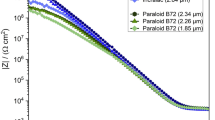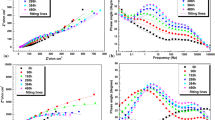Abstract
Copper coupons in sealed glass jars were exposed to corrosive drywall (CDW) and a moisture source while experiencing temperature variation from room temperature to about 120 °F (49 °C). After several weeks of exposure, the CDW source was removed and coupons were replaced into sealed glass jars with a moisture source for extended periods of time under similar temperature cycling. These coupons continued to corrode at a faster rate than coupons that had only been exposed to moisture in the absence of CDW. Analytical scanning electron microscopy (SEM) was used to augment weight change measurements. The results demonstrate that once corrosion is initiated by exposure to CDW, simple removal/replacement of the drywall will not mitigate the corrosion process.



















Similar content being viewed by others
References
Crangle, R.: Chinese drywall imports: how much came, when did it get here, where did it go? Presented at the technical symposium on corrosive imported drywall, 5–6 November 2009
Poole, J.L.: Understanding gypsum wallboard as a source of corrosive effects on building components. Presented at the technical symposium on corrosive imported drywall, 5–6 November 2009
Gill, M., Trotta, A.: Interim report on the status of the analysis of electrical components installed in homes with Chinese drywall. Consumer Product Safety Commission Draft Report, 23 November 2009
Freeman, G., Gauthier, T., DeMott, R., Hubbard, J.: Chinese drywall—the corrosion challenges. Presented at the technical symposium on corrosive imported drywall, 5–6 November 2009
Worthan, T.: Chemical emissions, including sulfur compounds, from Chinese produced drywall. Presented at the technical symposium on corrosive imported drywall, 5–6 November 2009
DeMott, R., Alessandroni, M., Hayes, H., Freeman, G., Gauthier, T.: Elemental sulfur and trace metal content in Chinese and domestic brands. Presented at the technical symposium on corrosive imported drywall, 5–6 November 2009
Tuday, M., Chen, K., Cherazale, H., Fortune, A., Henton, W., Parnell, C., Dangazyan, M., Cornett, C.: Measurement of corrosive, odorous, and potentially harmful gases from imported and domestic wallboard. Presented at the technical symposium on corrosive imported drywall, 5–6 November 2009
Hooper, D., Shane, J., Straus, D., Kilburn, K., Bolton, V., Sutton, J., Guilford, F.: Isolation of sulfur reducing and oxidizing bacteria found in contaminated drywall. Int. J. Mol. Sci. 11, 647–655 (2010)
Environmental Health & Engineering, Inc.: Final report on an environmental quality assessment of homes containing Chinese drywall. EH&E report 16512, 28 January 2010
Jacobs, S., Edwards, M.: Sulfide scale catalysis of copper corrosion. Water Res. 34(10), 2798–2808 (2000)
Author information
Authors and Affiliations
Corresponding author
Additional information
Many of the references listed can be found at http://www.drywallsymposium.com/blind/index.html.
Rights and permissions
About this article
Cite this article
Freeman, G.B., DeMott, R., Gauthier, T. et al. Continued Corrosion After Removal of Corrosive Drywall. J Fail. Anal. and Preven. 11, 265–273 (2011). https://doi.org/10.1007/s11668-010-9427-7
Received:
Revised:
Published:
Issue Date:
DOI: https://doi.org/10.1007/s11668-010-9427-7




